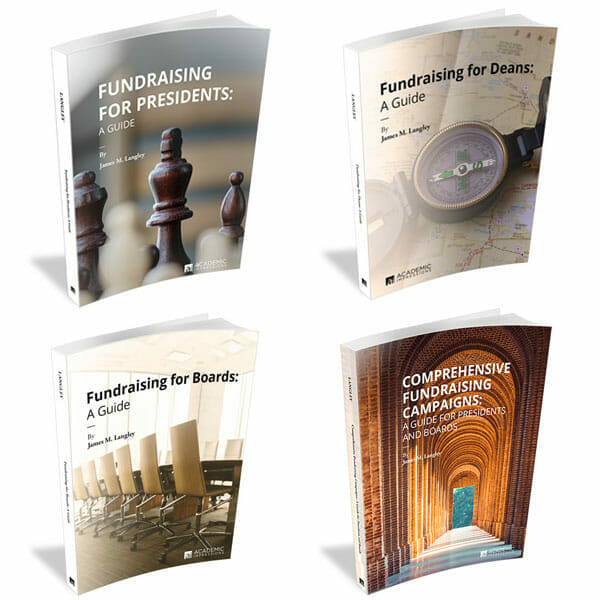
Series: Creating the Conditions for Support
Everyone is trying to raise more money. Rather than simply suggest the next tactic that can boost giving in the short-term, this series offers a more intensive look at the strategic thinking that drives philanthropic support: Why do donors give? How do institutions strengthen their core and emphasize initiatives worthy of support? How do we align strategic plans, strengths, and advancement strategy to create the conditions for ongoing and sustained support? In this series, distinguished current and past chief advancement officers apply their most innovative and creative thinking to this question.
Previously in this series:
Why Donors Give: It’s Not What You Think
More than Dollars: How Many Opportunities are You Missing with Your Alumni?
Engaging Women in Philanthropy: Practical Ways to Shift Our Approach
Checklist: Questions the Governing Board Must Ask Before Launching a Fundraising Campaign
If you were running a college or university and had the resources to hire only one person in advancement, what skills would you look for and why?
I’d look for someone with the skills of an outstanding “beat reporter,” – a naturally curious person with a nose for good human interest stories. I would ask him or her to circulate throughout the school looking for “admirable people doing admirable things who are constrained from doing even more admirable things by the lack of resources.”
The reason I would want this kind of person is because effective fundraising is based on our ability to tell compelling stories. This is the case because donors don’t want to give to schools merely to keep them afloat; they want to give through schools, to create a better world. Philanthropy is the means by which we seek and often succeed in improving the human condition. We know that donors give out of deeply held personal value systems, and that (according to a survey conducted by Cygnus Applied Research) they say they would give more if they understood better the impact of their gift.
Another way of putting this is that donors need a quest to achieve, and want to see institutions as heroic partners in that quest. Quest narratives are universal; they can be found in every human culture, now and in the past. What fundraisers need to do is develop compelling quest narratives that have these characteristics:
- A starting point and a depiction of the better place we want to reach and who will be better served when we do.
- A description of the hero (a person or a team) who is leading that quest, someone who has already accomplished a lot through hard work and self-sacrifice and who is willing to do more of the same in pursuit of a greater good.
- Why this quest matters to us all.
- Insight into what motivates our hero, at a personal level, to pursue this quest.
- What our hero has achieved thus far.
- Where the lack of resources is thwarting our hero from advancing the quest further.
- What new quest milestones might be reached if specific funding levels were secured.
- The consequences of failing to achieve these quest objectives.
If we develop compelling narratives around quests with audacious but attainable outcomes, we will attract significant and sustained philanthropic energy. This will be much more efficient to us than merely:
- Asking people to give to categories of funding (e.g. scholarships, faculty chairs, new buildings).
- Asking for ourselves rather than projecting a greater good to be achieved, (e.g. when we build campaigns around building endowment for our self-perpetuation).
- Asking people to give so that we might reach certain dollar goals rather than specific mission objectives.
- Asking people to give to processes that do not speak to impact or outcomes (e.g. interdisciplinary studies, mentoring, or international studies).
- Asking people to give again without explaining the impact of their previous giving or without projecting the impact of their future giving and describing how we are obligating ourselves to reach those goals.
Let us take a closer look at the power of quest narratives in inspiring philanthropic energy – in these two scenarios:
Scenario 1
Imagine the difference between reading a brochure asking you to give to cardio-vascular research versus reading a story in a university magazine in which you are told the story of a distinguished M.D./Ph.D researcher who lost his beloved father to heart disease when he was only 19, while he was enrolled in his first year of college. Imagine, if you were a potential donor, that you continued to read and learn that shortly after his father’s death, this student switched his major to pre-med and began a lifelong pursuit of ameliorating if not preventing heart disease, in the hope that fewer people would lose their parents before their time.
Further, imagine learning that this researcher and his team had identified several genetic markers that predisposed people to the early onset of heart disease, and this researcher is now zeroing in on a way to use other parts of the human genome to “knock out” one of those markers. Finally, imagine that you, a prospective donor, had lost your parent or another family member in a similar way, and that you now have the means to make a significant gift. Imagine how strongly you might now identify with this hero and his quest and how keenly you might want to join and support his efforts.
Scenario 2
Imagine that you are the parent of a special needs child, and imagine the difference between being asked by a major gift officer to give to a campaign category labeled “Improving Student Life” versus receiving an article from the campus newspaper that profiles the long-term dean of student life. As you begin reading, you learn the dean has suffered from a severe form of rheumatoid arthritis and has undergone 23 corrective operations. You read that notwithstanding the bend in her back, the twist of her fingers, and the unevenness of her gait, this dean has endeared herself to generations of students because of her warmth, concern, and helpful interventions. Indeed, she has become known to students and alumni alike as Dean Alma because she embodies the definition of alma mater – “nourishing mother.”
Reading further, and now eagerly, you learn that Dean Alma is now recognized as a national leader in developing programs that have led students with disabilities to graduate at a far higher rate than the national norm. After reading a quote in which Dean Alma says, “There are so many more ways we could help disabled students if we had more resources,” you pick up the phone to call the college and see how you can give to such a worthy leader who is so clearly having such a profound impact on so many students.
Conclusion
Yes, these are dramatic examples — but every institution has its quotient of admirable people doing admirable things, and many of those stories remain untold. Or they are not told in as compelling a fashion as they might be. If we send the right person in search of these stories and tell them what story elements to look for, then more compelling stories will emerge from your institution, and more donors will be drawn to them.
The old saying that “people give to people” is true but incomplete. People give to people with whom they identify, whose work they appreciate and admire, and whose “life goals” they share. Philanthropy is the means of joining doers and donors, of building partnerships of purpose, of aligning the interests of those who seek to improve the human condition in significant and lasting ways. I encourage you to consider hiring and developing gift officers who are highly skilled at identifying and telling these quest narratives.
More from Jim Langley
Jim Langley is the author of a series of powerful fundraising guides for campus leaders: Fundraising for Presidents, Fundraising for Deans, Fundraising for Boards, and Comprehensive Fundraising Campaigns.

“This is is a treasure trove of great advice, forward-thinking reflections, and the tough, but much needed questions that presidents, boards, vice presidents and deans need to ask one another before embarking on a fundraising campaign.”
Matthew T. Lambert, Vice President for University Advancement, William & Mary


